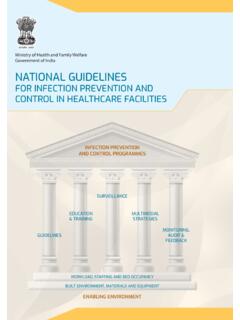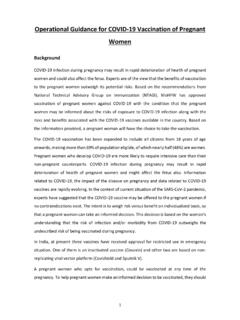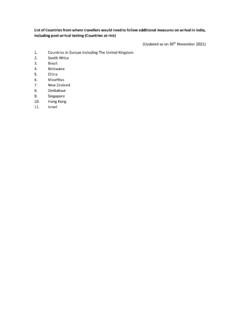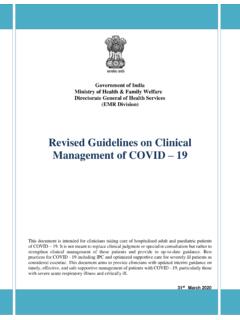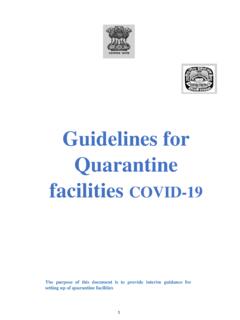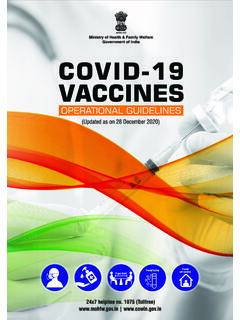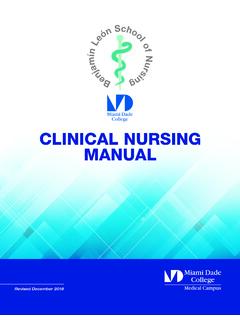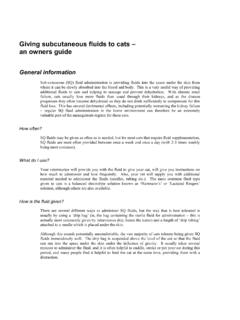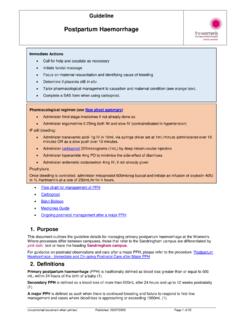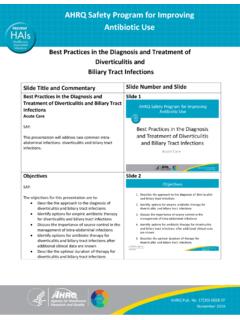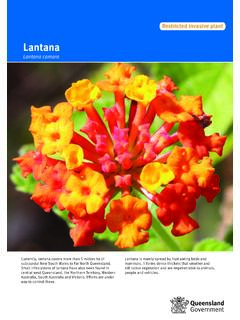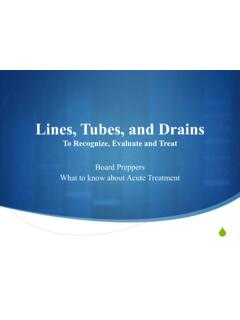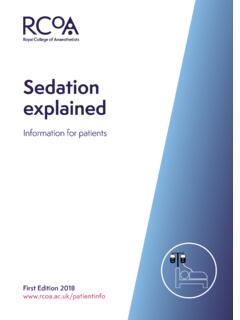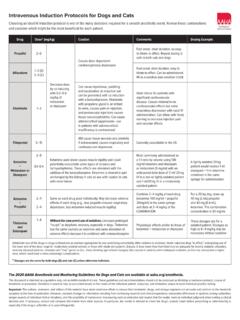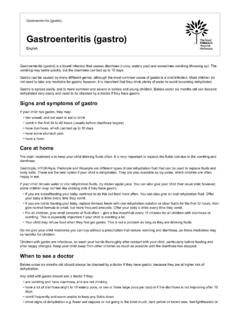Transcription of Guidelines for Management of COVID-19 in Children (below ...
1 18th June 2021 Guidelines for Management of COVID-19 in Children (below 18 years) Ministry of Health & Family Welfare Government of India Guidelines for Management of COVID-19 in Children Page 1 of 9 Mainstay of Treatment For fever, give paracetamol 10-15mg/kg/dose; may repeat every 4-6 hours For cough, give throat soothing agents and warm saline gargles in older Children and adolescents Fluids and feeds: ensure oral fluids to maintain hydration and give a nutritious diet No other COVID-19 specific medication needed Antimicrobials are not indicated Maintain monitoring chart including counting of respiratory rate 2-3 times a day, look for chest indrawing, cold extremities, urine output, oxygen saturation, fluid intake, activity level, especially for young Children Promote COVID appropriate behaviour (mask, strict hand hygiene, physical distancing).
2 Please see guide for using mask Advise older Children and family to stay connected and engage in positive talks through phone, video-calls, etc. Parent/caregivers to contact the doctor in case of deterioration of symptoms Severe SpO2 <90% on room air Any of the following signs of severe pneumonia, acute respiratory distress syndrome, septic shock, multi-organ dysfunction syndrome, or pneumonia with cyanosis, grunting, severe retraction of chest, lethargy, somnolence, seizure For other symptoms.
3 See COVID-19 symptoms at a glance Mainstay of Treatment Initiate immediate oxygen therapy and maintain target SpO2 94 96% Maintain fluid and electrolyte balance Corticosteroids therapy to be initiated Anticoagulants may also be indicated In case Acute Respiratory Distress Syndrome (ARDS) or shock develops, initiate necessary Management ; see ARDS and Shock guide Antimicrobials to be administered if there is evidence/strong suspicion of superadded bacterial infection; see antimicrobial use guide May need organ support in case of organ dysfunction renal replacement therapy Admit in HDU/ICU of COVID-19 Hospital Moderate In addition to symptoms in mild cases, check for pneumonia which may not be apparent Rapid respiration (age-based): <2 months RR 60/min; 2-12 months, RR 50/min; 1-5 years, RR 40/min; >5 years, RR 30/min.
4 AND/OR SpO2 90 93% on room air For other symptoms, see COVID-19 symptoms at a glance Mainstay of Treatment Initiate oxygen if SpO2 is <94% and maintain between 94 96% Maintain fluid and electrolyte balance oEncourage oral fluids (breast feeds in infants) oInitiate intravenous fluid therapy if oral intake is poor Corticosteroids are not required in all Children with moderate illness; they may be administered in rapidly progressive disease Fever with temperature >38 C (or F): Paracetamol 10-15mg/kg/dose; may repeat every 4-6 hours Anti-microbials to be administered if there is evidence/strong suspicion of superadded bacterial infection.
5 Please see antimicrobial use guide Supportive care for comorbid conditions, if any Admit in DCHC or COVID-19 Hospital Asymptomatic Suspected contact [RAT or RTPCR negative or not available] Incidentally detected [RAT or RTPCR positive] Mainstay of Treatment Infants and younger Children to stay under immediate care of parents/guardians No specific medication required for COVID-19 infection Continue medications for other conditions, if any Promote COVID appropriate behaviour (mask, strict hand hygiene, physical distancing).
6 Please see guide for using mask Fluids and feeds: ensure oral fluids to maintain hydration and give a nutritious diet Advise older Children and family to stay connected and engage in positive talks through phone, video-calls, etc. Parent/caregivers to contact the doctor in case of appearance of symptoms Home isolation (tele consultation SOS) Investigations No investigations needed Investigations Baseline: CBC including ESR, blood glucose, CRP, LFT, KFT, serum ferritin, D-Dimer Chest X-Ray Investigations No investigations needed Mild Home isolation (tele consultation SOS) or COVID Care Centre Sore throat, rhinorrhoea Cough without breathing difficulty SpO2 94% on room air For other symptoms, see COVID-19 symptoms at a glance Exercise caution.
7 See use of corticosteroids and anticoagulants guide Investigations Baseline: CBC including ESR, blood glucose Chest X-Ray Remdesivir (an emergency use authorization drug) is NOT recommended in Children There is lack of sufficient evidence on safety and efficacy with respect to Remdesivir in Children below 18 years of age CT chest is not indicated in diagnosis or Management of COVID-19 infection in Children Consider CT chest only if no improvement in respiratory status Guidelines for Management of COVID-19 in Children Page 2 of 9 Common symptoms Fever Sore throat/throat irritation Diarrhoea Cough Body ache/headache Anorexia/nausea/vomiting
8 Rhinorrhoea Malaise/weakness Loss of sense of smell and/or taste Differentiating symptoms/signs Asymptomatic Mild Moderate Severe Respiratory rate/min Normal with age dependent variation Normal with age dependent variation Rapid respiration (age based) <2 months 60/min 2-12 months 50/min 1-5 years 40/min >5 years 30/min Rapid respiration (age based) <2 months 60/min 2-12 months 50/min 1-5 years 40/min >5 years 30/min SpO2 on room air 94% 94% 90% <90% Grunting, severe retraction of chest +/- Lethargy, somnolence +/- Seizure +/- COVID-19 symptoms in Children at a glance Guidelines for Management of COVID-19 in Children Page 3 of 9 Management of Acute Respiratory Distress Syndrome (ARDS)
9 And Shock guide Management /treatment of ARDS ARDS may be classified based on Pediatric Acute Lung Injury Consensus Conference (PALICC) definition into mild, moderate and severe Mild ARDS o High flow nasal oxygen (start with L/kg/min to begin with and increase to 2 L/kg/min with monitoring) or non-invasive ventilation (BiPAP or CPAP) may be given Moderate Severe ARDS o Lung protective mechanical ventilation may be initiated; low tidal volume (4-8 ml/kg); plateau pressure <28-30 cmH2O; MAP <18-20 cmH2O; driving pressure <15 cmH2O; PEEP 6-10 cmH2O (or higher if severe ARDS); FiO2 <60%; sedoanalgesia neuromuscular blockers; cuffed ETT, inline suction, heat and moisture exchange filters (HMEF) o Avoid frequent disconnection of ventilator circuit, nebulization or metered dose inhaler o Restrict fluids; calculate fluid overload percentage, keeping it <10% o Prone position may be considered in hypoxemic Children if they are able to tolerate it o Daily assessment for weaning and early extubation.
10 Enteral nutrition within 24 hours, achieve full feeds by 48 hours o Transfusion trigger Hb <7g/dL if stable oxygenation and haemodynamics and <10 g/dL if refractory hypoxemia or shock Management of shock Consider crystalloid fluid bolus 10-20 ml/kg cautiously over 30-60 minutes with early vasoactive support (epinephrine) Start antimicrobials within the first hour, after taking blood cultures, according to hospital antibiogram or treatment Guidelines Consider inotropes (milrinone or dobutamine) if poor perfusion and myocardial dysfunction persists despite fluid boluses, vasoactive drugs and achievement of target mean arterial pressure Hydrocortisone may be added if there is fluid refractory catecholamine resistant shock (avoid if already on dexamethasone or methylprednisolone) Once stabilized, restrict IV fluids to avoid fluid overload Initiate enteral nutrition sooner the better Transfusion trigger Hb <7g/dL if
